Two months with the bees
Introducing my trip
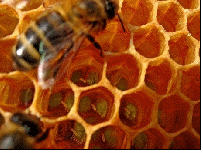
This summer I spent two months in Norfolk with Keith Morgan. I found this opportunity due to the website Helpexchange. net. For the cost of 20 euros I was able to access HelpX where there are over 1,000 hosts all over the world. These hosts provide food and accommodation for work experience.
My host (Keith Morgan) lives in Norfolk, in a small village called Little Massingham. It is located fifteen miles east of King's Lynn.
Why did I choose to go with this host? On the website, most hosts expect you to do renovation, gardening, farming, childminding etc. What struck me with this host was beekeeping. There are only two beekeepers on HelpX. I helped my father in the past to renovate the attic in my house to do new bedrooms so renovating a house in England was less interesting than beekeeping. It was for me the opportunity to learn something new, something you can't learn at school or in a book. Moreover I have always been interested in bees. Keith also has a little farm: he has 120 chickens, five pigs and twelve turkeys.
Keith has around 200 hives (it's impossible to know how many he has in reality as some die and he sometimes makes new hives). He has them mostly in Norfolk but he moved them to other crops in UK (Cambridge, Yorkshire, Derbyshire (for these two see the chapter about moving bees to the Heather)). These crops are mainly fruit blossom, borage and heather. Keith has a lot of work to do with his own hives to inspect all of them and to do what is required for each of them but he has also to inspect the hives of a lot of other people as he is a bee inspector. When I came he was just promoted to regional bee inspector, he now has the responsibility of Lincolnshire, Rutland, Leistershire, Cambridge, Suffolk, Essex, Hertfordshire, Bedfordshire and of course Norfolk. He is in charge of other inspectors too. As a bee inspector, he works for DEFRA (Department for Environmental Food and Rural Affairs). He deals with statutory notifiable diseases which are European fool brood (EFB) and American fool brood (AFB). He also does checks for small hives beetles as well as giving advice on varroa management and Tropilaps. He works as a bee inspector in the week and he takes care of his hives at the week-end.
Beekeeping
The honey bee familly
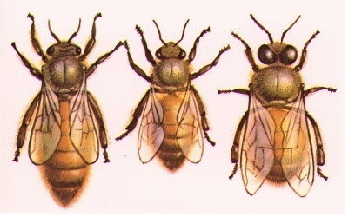
The Queen, a worker and a drone
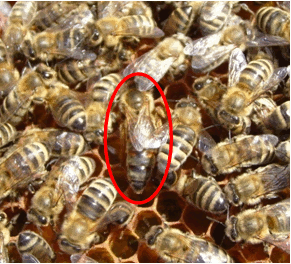
The Queen with worker bees
In a beehive you can find three types of bees: the worker bee, the drone and the queen.
All the workers are females, they are the ones who bring the pollen and the nectar to the hives, they also take care of the young bees, keep the hive tidy, ventilate the hive if necessary, feed the queen etc. The worker bee has a sting that she uses to protect the hive. The sting has a barbed end so when she stings a mammal or a human the barb end get stuck and leave the venom sack which is a part of the bee then the bee dies. Fortunately the bee can sting other instects again and again to defend the colony without dying.
The queen is the heart of the colony: she lays eggs and she produces pheromones to regulate the work in the colony and to manage the workers. The queen is the most important member of the hive. Every beekeeper will look every time if there is the queen is the hive and if she is laying well.
The queen has a sting but she only uses it to sting other queens. She is the largest bee in the colony with a long body.
The male bee is called the drone, they are the largest bees in the hive but they are unable to sting. Their only purpose in a hive is to mate with a virgin queen. When a virgin queen goes out of the hive to mate all the drones come with her. They die after mating. A queen will mate with severals drones during her nuptial flight. The drones do nothing in the hive they just eat and they don't work.
The beehive
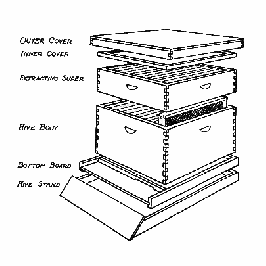
The beehive
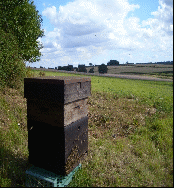
The modern hive is also called Langstroth hive. (It's not the only type of modern hive but it's the most common.) The important thing in a beehive is the bee space: this bee space is the distant between two frames. If this space is too small the bees will glue the frames together with propolis (bee glue). If the space is too large, the bees will build another comb in the middle.
The parts of the hive are the hive stand, the bottom board, the hive body (brood chamber), the queen excluder, the super(s), the inner cover and the outer cover
The hive stand is made to elevate the hive of the ground to insulate the hive and it's more natural for the bees to be off the ground because they normaly live in trees.
The bottom board is the thick bottom floor of the beehive, some beekepers use screened bottom boards which improve the ventilation of the hive (that could be useful in the hot summers).
The hive body: this is where the bees live, it contains ten frames, in which you find eggs, larvae, brood, honey and pollen. In this part of the hive you can find the queen (if you have good eyes!).
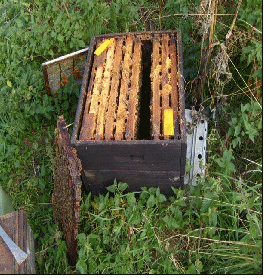
The queen excluder: this is a wooden frame holding a grid of metal wire. It is placed between the brood body and the supers. As the name implies it prevents the queen going into the supers to lay eggs. If the queen lays eggs in the supers you cannot take the honey away.
The super is the part of the hive that you place on top of the brood chamber (hive body) so the bees can store honey. When the super is full you place another super on. In each super you have ten frames of honeycomb (not as big as the ones in the brood chamber). A full super weighs an average of 20 kilograms.
The inner cover is a framed flat plank with a hole in the middle. We also call it a crown board.
The outercover or the roof: it's a frame of wood with a galavanized steel tray on the top. It protects the hive from the rain and other elements.
The fundamental tools for a beekeeper
The smoker
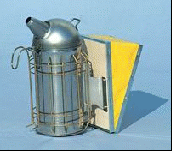
This is an indispensable tool, the beekeeper never inspects a hive without it. The smoke calms the bees and enables the beekeeper to safely look in his hive. A smoker is simply a fire chamber with bellows designed to produce lots of cool smoke. What is burnt inside the smoker is irrelevant but we never use anything synthetic or toxic for the bees. We can use paper, dry grass, wood etc… Keith uses sacking to put in his smoker.
Why does the smoke calm the bees? In nature the bees live in hollow trees so if they smell smoke it means for them that there is a fire in the forest where they live. They feed themselves with honey from the hive and that make them gentler. The other explanation is that the smoke masks the alarm pheromones given off by the worker bees when the hive is opened. With the smoke they are unable to communicate so they can't know the beekeeper is here.
The hive tool


This is another indispensable tool, it is a very simple tool made of metal. The beekeeper uses it to take out the frames from the hive and to scrape the wax and propolis (bee glue).
Bee-proof clothing
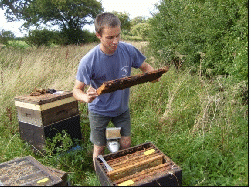
When the beekeeper visits a hive he usually wears an overall. I say usually because it's possible to do without it if the bees are very friendly (see this picture of me). The overall is white but can also be light colour as the bees don't like dark colours. This bee-suit covers all the body but not the head. To cover it he uses a veil. It's better to wear wellingtons as the bees are curious and like to see what is in the overall. They don't want to sting you but just see what is inside. I had a bee in my overall many times or in my veil and they never stung me. The problem with simple shoes is that the bees go on your sock and when you move your foot, they may be blocked between it and your shoe and then they sting you. One day I wore simple shoes and I was stung five times on the ankle and I can say that it is the worst place to be stung.
What the beekeeper has to do?
The beekeeper has a lot of things to do in order to keep his bees productive and alive. Some activities have to be done every time he visits the hive and others are seasonal activities.
What to inspect in the hive every time?
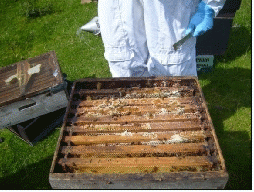
A super on top of the roof placed to not crush the bees
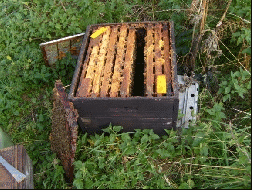
A frame full of bees placed out of the hiveto have enough space to inspect the other frames
The first things to know is that the bees are gentle and not aggressive at all. If they want to sting it is because the beekeeper treats them badly or there is a problem in the hive (queenless or they have got diseases for example). Keith used to say to me “treat them like your girlfriend”, and that is true. If the beekeeper crushes a bee it releases a pheromone which raises the alarm in the hive, the consequence will be that the bees will now want to sting.
When the beekeeper opens a hive he smokes the entrance first to say to the bees that he is there then he opens it gently. If the different parts are stuck with propolis, he uses his hive tool to tear them apart but he has to be careful to avoid making a loud crack. It is not the noise which alarms the bees but the vibration in the entire hive. The beekeeper places the roof on the floor upside down, then takes the crown board off first checking the queen is not on the underneath, this is placed stood upright against the hive. He places the super(s) crossway on the roof like you can see on the picture.
After removing everything on top of the hive, he then inspects the frames. To do this he can begin at one end but the experienced beekeeper will begin by the middle as the interesting frames are here. He takes one frame out of the brood body with his hive tool and looks at it. If this frame is from one end it is usually empty (empty of broods, eggs and larvae but not of bees) he puts it against the hive being careful to not crush any bees. The beekeeper places only the first frame out so he has enough space to look at the other without crushing the bees between the frames. If the first frame he has taken is a frame from the middle there is chance that there will be brood larvae and eggs on it. If he doesn't see them on the first frame he places it against the hive and looks at another frame. The beekeeper has to look at them so he is able to see if the hive has a queen or not. As I have explained “the queen is the most important member of the hive”, without her the colony is doomed to failure and the beekeeper is sure that he won't have any honey.
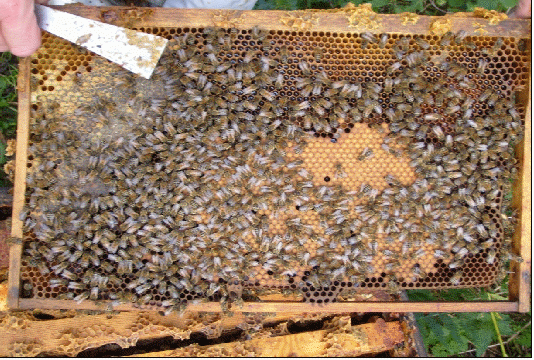
A frame with a very good pattern of broods
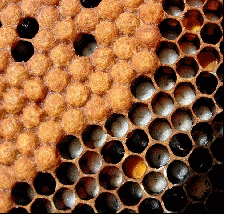
The broods are the last stage of the development of the baby bee, they indicate that the queen was here between nine and twenty one days before so it doesn't indicate that the hive has still a queen. It's the same problem for the larvae, they indicate that the queen was there between four and eight days before. The only way to know if the queen is in the hive is to see eggs as she laid them between one and three days before. They are very difficult to see as they are very tiny (0,4 mm diameter, 3 mm length). If he is unable to see them he then tries to find the queen but it is very difficult to find her especially since they are 50,000 others bees in the hive. It is really easy to miss her and she may not be there. Some beekeepers mark the queen so they are able to see her easily and they know if the queen they see is still the same queen they marked (it could be a new queen).
Avoiding the swarms
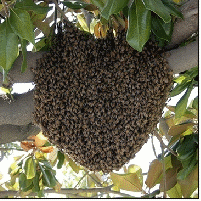
A swarm
In the months of April, May, June and July, the beekeeper has to prevent the bees from swarming. The swarm is the natural method of expansion for the bees: a new queen leaves the hive with half of the bees. Before swarming, the bees that intend to leave the colony gorge themselves with honey. When a hive swarms it is not good for the beekeeper as he loses all his production for the year.
The first sign the beekeeper knows that the hive is about to swarm is the queen reduces the egg laying and the bees make queen cells. The reason the queen is reducing egg laying is because the bees stops feeding her in order for her to lose weight which enables her to fly. The old queen flies off with the prime swarm leaving behind queen cells that hatch if the beekeeper doesn't go through the hive and destroy all the queen cells but one. Every new queen will swarm with bees, these swarms are called casts. The beekeeper prevents the old queen from swarming by clipping her wings. A new colony never swarms, it is usually the colonies with a two-three year old queen and a big stock of bees which swarm. As a new queen won't usually swarm, a method to prevent swarming is to replace the queens in the hives every autumn.
If the beekeeper thinks that his bees will swarm if he does nothing, he can decide to destroy all the queen cells or to do an artificial swarm. The method which consists in destroying the queen cells is good unless the beekeeper forgets one queen cell. In that case a queen will emerge and the hive will swarm anyway. This method is good but if the bees make other queen cells he will need to use the method of the artificial swarm.
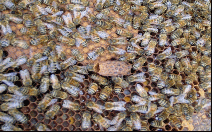
Hatched queen cell
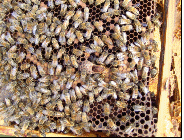
Destroyed queen cell
The second method takes more time but the beekeeper can have a new hive if he desires (he will lose a little bit of honey). To make this artificial swarm he needs to have another brood chamber, floor, crown board and roof. The beekeeper moves the hive two feet away from its location with the entrance facing the same way and places the new brood chamber on the floor at the place of the suspect hive with ten frames with foundation or drawn comb in them. Then he takes the frame with the queen on it from the old hive, destroys the eventual queen cells on it and places it in the new brood chamber. He places the supers on top of the new hive and closes the roof. If the supers are empty he has to feed the bees of the new hive; he has to do the same in the old hive if the frames left are empty of honey. Automatically the flying bees will return to their old place with the queen in the new hive. The non flying bees will stay in the old hive. The beekeeper has to destroy all the queen cells but one he chooses, this one will hatch and give a new queen. If the beekeeper leaves two queen cells both will hatch and the bees will swarm.
Once the queen has mated and begisn to lay, the beekeeper can keep this hive or unite it with the new one (where he has put the old queen). Uniting it with the new one has the advantage to not lose any honey for the harvest and to replace the old queen. Indeed to unite them he has to find the old queen and kill it or the hive will have two queens. One will kill the other and the beekeeper wants to keep the new one. After killing the old queen he places the old brood chamber on top of the supers with a sheet of newspaper between them. In this sheet he makes some holes with his hive tool so the bees can go through. The bees in the top brood chamber will go down within few hours. The time delay accustoms them to one another without fighting. When the bees are down he places the top brood chamber instead of the bottom one. With the bottom one he shakes the bees in the top one which is now the one on the floor and places the frames with brood in it. If there are more frames of brood than space they can be placed in a weak hive or left in the brood chamber on top of the united hive until the brood hatched (he removes it after).
Getting the bees ready for the winter
The start of the preparation for the winter is in August when the beekeeper treats his hives for varroa (see the chapter about moving the bees to the heather to know how to treat). The next thing to do is to check if the queen is in the hive. She might not lay if she is an old queen so the beekeeper has to find her. The beekeeper can choose to replace all the old queens as it usually prevents the bees from swarming the next spring/summer. Once he is sure all the hives have a queen (old or new), he checks the food stores, determines if they have enough and if not how much sugar they need. Knowing the quantity of needed sugar relies on the experience of the beekeeper but he can feed them until they stopped to take it. The beekeeper needs to feed all his bees at the same time to prevent any robbing behavior. The first gallon (a gallon is 3,78L) of sugar is medicated with Fumiligin-B which is against Nosema (a disease). He places a mouse guard, at the entrance of the hive, this could be a metal plate with 3/8 inch round holes but it could be other types. The mice will enter any hive without it and do a lot of damages in it. The bees which are in a cluster in the cold of the winter won't do anything to protect themselves.
Another predator is the green woodpecker, once the woodpecker understands the tricks which consists in feeding with a hive he may do all the hives in the apiary. He will make a hole in the hive, enter it and eat everything inside. The beekeeper might find only pieces of wood as big as matches in the hive after a woodpecker has entered it. An easy way to prevent it is to cover the hive with wire netting or fishing netting before the first frost. The last thing that can be done before the winter is to ventilate the hive by raising the crown board upon ¼ inch blocks in the corners. It allows the wet air to flow out at the sides without creating a draught through the cluster. Ventilation is something the beekeeper has to experiment and see if it suits his bees in the next season.
Preparing frames
Preparing the frames and repairing the hives are part of the job of the beekeeper. It's usually done in the winter time when he doesn't need to go out and see the bees and when the weather is bad.
In Engand they use a lot of different hives listed below: Nationals, smith, WBC, Langstroth, Dadant, Commercials, 12x14, Jumbo, British standard, 16x10 and Modified Commercials. Keith uses modified Dadant Hives and few British standard which are able to take a modified Dandant supers.
There are different types of frames used in each hive but I will show you how to make super frames which are used for cut comb.
The first thing to do is to take out the wedge bar as you will use that later. The second thing is to glue the side bars with the top bar and to nail it. The last thing is to nail the two bottom bars to the side bars. Once everything is done you have something like this:
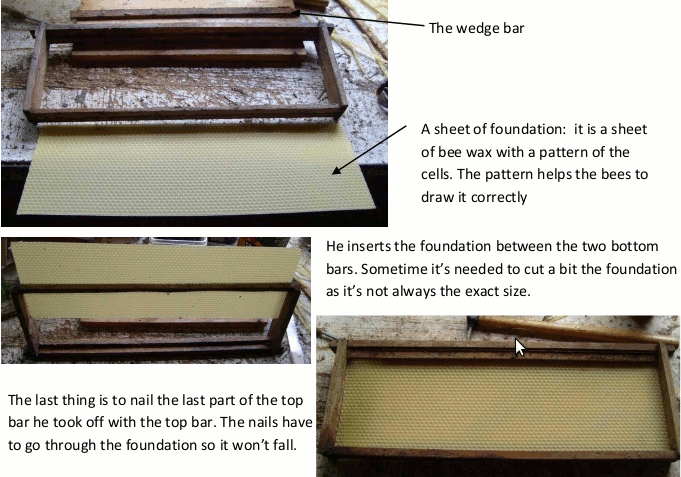
Re-using the frames and hives boxes
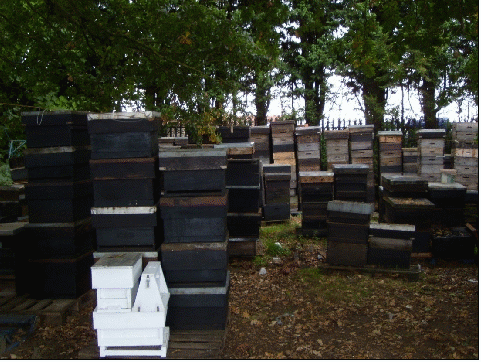
Stacks of empty hives and supers
The beekeeper is able to re-use frames. The super frames are re-used continuously, the only time that they are melted down is when honey solidifies, this particularly with Ivy honey which granulates very rapidly.
When we remove any dead hives we melt the frames down to remove the wax and then all these frames together with any super frames that have been melted down are washed in boiling water and soda. These frames are then placed in the brood boxes/supers and are then ready to be re-waxed for the next year.
The brood boxes are scraped and scorched out with the blow torch in order to kill any diseases or wax moth (wax moth cause a lot of damage in weak hive going through all the wax eating everything).
Moving the bees to the heather

Heather flowers
The first week in August the heather was coming to flower: It was time to move the bees. Moving the bees is a hard job. There are a lot of things to do before moving them.
Our first decision is to decide which hives we will move. There is no point in taking weak hives, as they won't give us honey. The second thing is to determine if the hives need to be fed before leaving. Some hives are big stock of bees but they don't have any honey in the frames. We need to feed them so the bees won't starve and they will more likely put the honey in the supers. To feed the hive we put a feeder on top and we fill it with syrup. The syrup is made with sugar and water. The bees go into the feeder and can drink the syrup without being drawn into it. They can drink all the syrup in one night but we need to feed them one day before getting them ready.
The next thing to do is to treat them with thymonate. We treat them with a yellow strip cut in half on top of the frames of the brood chamber. This strip is made of thymol to kill the varroa mite which does a lot of damage in the hives. When the hive is treated we put a super on with a ventilated cover which is screwed on top of the super. This cover allows ventilation so the bees won't suffocate: indeed before moving them we will block the entrance of the hive. The last thing to do to get them ready is to staple all the parts of the hive so it won't move in the truck. Usually the bottom board and the hive body are already stapled but we have to staple the hive body with the super (sometimes we have two supers on top which we have to staple together). See the picture below to know how to staple correctly. We staple like this because of the organisation on the truck (see picture below), indeed the major movement is from the front to the back. We put the entrance facing the front so the frames are well positioned and we always know where the entrance is (very useful for the unloading).
Once we stapled the entire hive we have to check for holes big enough for bees to escape. We will carry the hives and the bees won't like it at all so we don't want them to get out and sting us (we don't wear overall at this moment). We block the holes with tape which we place all around the hive where the hole is because if we don't do that the tape falls and the bees would be able to get out! After that the bees are ready to be moved.
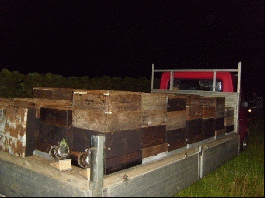
The hives loaded on the truck: all the hives are facing the front
We can place 28 hives on the back of the truck, in order to have these 28 hives in one place the previous night we brought them from various sites. The first evening we don't place the hives into the roofs because we are only moving them for a short distance. When we are moving them for a long distance we place them in the roofs. We move the bees in the evening because the bees are not flying so they are all in the hive. If we take the hive away, the bees left might not find a hive where they will be accepted so they die. We can also move them in the day if the weather is very wet or cold but it's much better to do it in the evening.
When we go to the hive we block the entrance with a foam block so they are unable to get out, that's why we don't need to wear an overall. The second evening we just have to block the hive again (when we finished to moving them the day before we left them out), to place it in its roof (like that they have ventilation) and to place everything (hive in its roof) on the back of the truck. As the 28 hives are all in the same place, it doesn't take a long time to load them all. Once they are on the truck, we place the crates (Keith uses crate as hive stand) on top of them and we cover them with the tarpaulin to protect them.
We did the first two trips to Derbyshire to a place called Baslow. The trip took two and a half hours from home. When we arrived we unloaded the bees, we placed them in squares with the entrance facing out. We arrived back in Norfolk at 2,30 am. When we moved the bees to Yorkshire we slept in a tent in the same field as we placed the bees because the trip lasted for four hours.
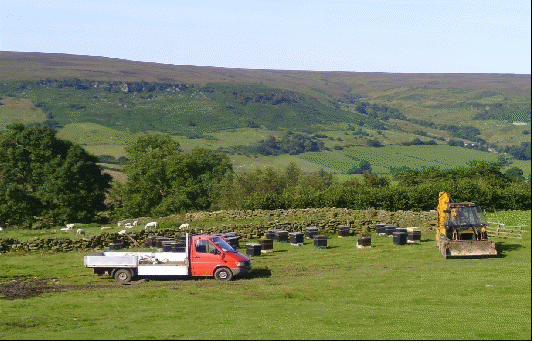
The result of these movements of bees
Two weeks after we moved the bees to the moors we made a trip up to check the bees to see if they required anymore supers. We brought with us a few supers to add on top of very good hives. Due to the weather we had had we did not expect very much honey. Ideally if the weather had been sunny, hot and without wind we would have placed more supers on the hives. If the weather is ideal the bees would been able to fill the super in three days especially since they had all this heather-moorland around them.
Sometimes the beekeeper can do everything he can, if he hasn't the right weather, all his effort will have been a waste of time. Last year Keith moved the bees like we did this year but he didn't have any honey from the heather. In fact even if the weather is not good and they don't bring any honey in the supers, they still bring honey in the brood chamber. This is good because if the bees have honey there they don't need to be fed before the winter.
I was not involved in bringing the bees back to Norfolk but I know that the first lot of bees they brought back was a pleasant surprise as half of the hive has brought some honey in. This lot was from Derbyshire so it was a really good surprise because when we had been up to check the hives, the supers had been empty.
The Honey
Extracting it
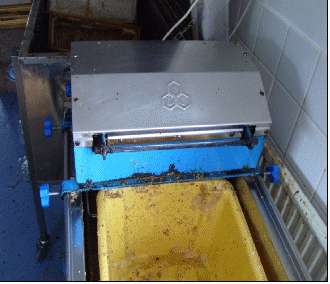
The uncapping tank
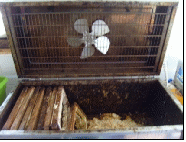
The sweinty melter
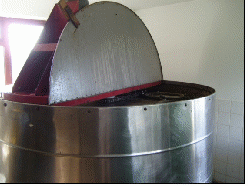
The extractor
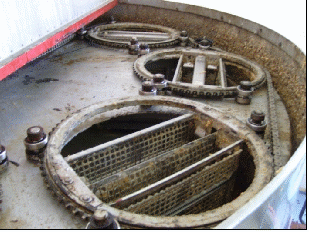
The change mechanisms
Extracting the honey is an operation which is not Keith's priority as he has a friend who does it for him. Full supers are brought back in the Honey house and then are extracted at the week end. He has big machines as he doesn't want to spend all his time doing it. The process of extracting the honey starts with uncapping wax from the frames of honey and placing it in a large extractor. The uncapping could be done with a sharp knife but Keith uses an electric knife as he has a lot of frames to deal with. With it he cuts the wax seal which closes the honey so he can extract the honey afterwards. While he is doing this the seal and some honey fall in the uncapping tank which has a wire mesh in the bottom where the honey drains leaving the wax. Any comb where the honey is hard is melted down in the sweinty melter.
This picture on the right shows the uncapping tank with the knife. You can see the wire bottom but here there is a crake to retrieve the wax seal and the honey and to put it in the melter where he melts it.
When the extractor is full with 36 frames he switched it on; because it is a tangential extractor it is only able to take the honey out of one side of the comb, you have to slow the machine down after five minutes and turn the frames round this is done by a change mechanism which turns the cages inside the extractor.
The extracted honey is filtered through a sump which consists of two layers of fine mesh and then it is pumped into 46 gallons drums which hold 660 pounds of honey.
The different types of Honey
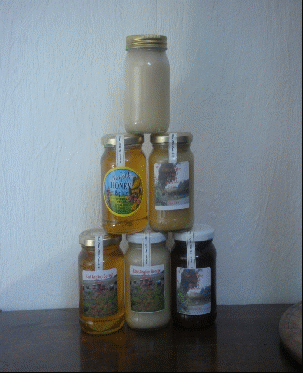
You find as many type of honey as there are flowers; they have different flavours and different colours. Keith sells five type of honey at the farmer market in London but this summer we had only three types. Every honey is either set which is granulated or clear. The granulation of the honey is natural but it is possible to melt it by heating it gently (40 ℃). As I said the honey granulates naturally but to do set honey we first heat up, filter it and pump it in a settling tank where we mix some granulated honey into it, mixed it and then let it go hard. After two weeks we warm this honey up then mix it and bottle it.
The different types of honey Keith has are:
- Norfolk honey: this honey varies in taste from mild, gathered in spring from fruit blossom, to a slightly stronger taste from Hawthorn around May/ June, to full flavoured from Sweet Chestnut in July.
- Borrage honey: a very mild and delicate honey ideal to use in teas and on cereal. Borrage is an herb grown in Essex. The oil is used in yoghurt, baby food and also sold in health food shops as starflower oil.
- Ivy honey: this is the last crop of honey removed from the bees, a stronger nutty taste which granulates quickly; this makes extraction tricky. Very good when used in cooking and as a glaze for parsnips.
- Sea lavender: this is a plant found on the marshes of the Norfolk coast, and gives the honey slightly bitter after-notes, favoured by connoisseurs.
- Unfiltered/ raw honey: this honey is mainly Borrage. It is extracted and bottled without heating or filtering, so you will find wax and pollen etc.
- Cut comb: this is honey from Borrage and is unprocessed as you can get! The bees store both honey and pollen in the comb.
- Heather Honey: the heather honey, as I explained is a summer honey from the heather flowers. It's a very special honey because it is one of the few honeys which is not liquid but it's a jelly with a multitude of tiny air bubbles which give a characteristic sparkle. The heather honey is hard to extract because of its jelly consistency which is thick.
